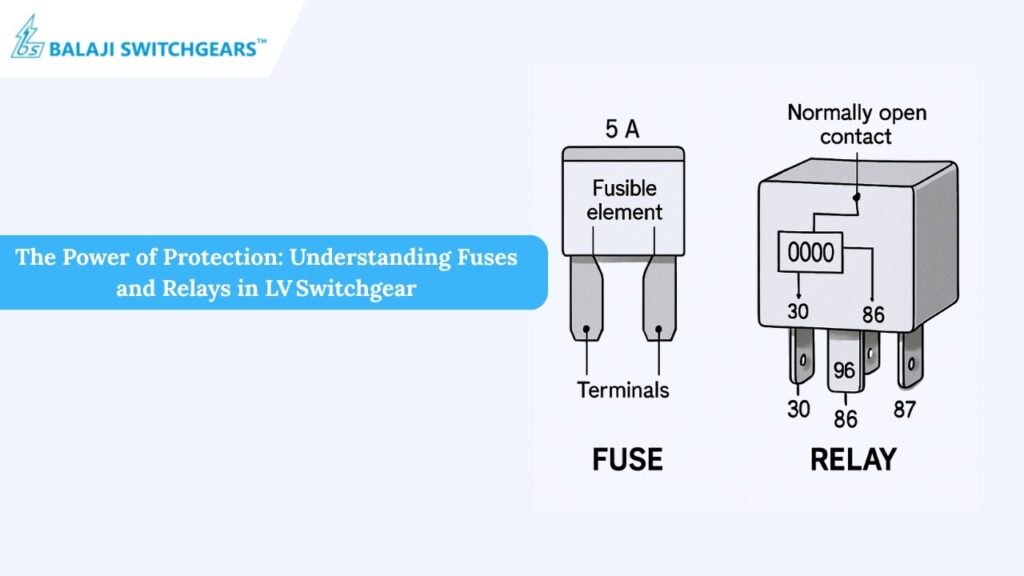In every modern electrical network, LV Switchgear acts as the central nervous system—controlling, isolating, and protecting power flows. Within this framework, Fuses and Relays play distinct yet complementary roles. This blog dives into how these vital components interact within low voltage switchgear, boosting safety, reliability, and performance in facilities worldwide, including top-tier systems like Schneider Electric Switchgear.
1. What Is LV Switchgear?
Low voltage switchgear refers to assemblies that manage power distribution at voltages up to 1 kV. These systems include circuit breakers, fuses, relays, busbars, and more, all designed to ensure power flows efficiently while isolating or interrupting circuits under fault conditions
When properly designed, LV Switchgear supports seamless operation, quick fault clearance, effective load management, and easier maintenance.
2. The Role of Fuses
A Fuse is a simple yet powerful protective device. It contains a metal strip or wire that melts when current exceeds its rating, instantly breaking the circuit
Why fuses matter:
- They respond extremely fast—within milliseconds—to short circuits .
- With predictable time-current characteristics (per IEC 60269 standards), coordination among upstream and downstream protection is easier and more reliable
- Fuses offer selective protection: only the faulty feeder is isolated, preserving power to the rest of the circuit.
Advancements include compact fuse holders, improved insulating materials, and even smart fuses that can report their status, making them ideal in modern low voltage switchgear systems
3. The Role of Relays
Relays are intelligent control and protection devices. They monitor electrical parameters like current, voltage, or frequency and activate circuit breakers when anomalies are detected .
Key relay functions:
- Overload protection: thermal or electronic relays prevent damage due to motor overcurrent, while fuses handle short circuits
- Selective tripping: coordination with breaker or fuse settings ensures only the faulty section is removed
- Control features: relays enable automation—remote switching, load shedding, motor logic, and event logging.
In systems like Schneider Electric Switchgear, relays often integrate into energy management and communication networks, supporting smart grids and predictive maintenance.
4. Fuses vs Relays—Comparison
| Feature | Fuses | Relays |
| Speed | Ultra-fast for short-circuits | Fast but typically slower than fuses |
| Reusability | Single-use; replace after trip | Resettable; reusable |
| Coordination capability | Excellent selectivity | Excellent with breaker coordination |
| Cost | Simple, low-cost | Higher upfront but richer in features |
| Automation | Basic (no logic) | Advanced control, protection functions |
Fuses excel in high-speed short-circuit protection, while relays offer intelligent monitoring and multi-fault protection—making both crucial in low voltage switchgear
5. Integration Within LV Switchgear
Inside a typical low voltage switchgear assembly:
- Fuses protect branch feeders and motors.
- Relays, often built into breakers or separate units, manage overloads, short circuits, ground faults, and dynamic control.
- In Schneider Electric systems, relays are networked—providing remote status updates, diagnostics, and predictive alerts.
This symbiotic setup ensures:
- Isolation only of the faulty part.
- Fast fault interruption.
- Smart monitoring and data-driven maintenance.
6. Real-World Example
Consider a processing plant using Schneider Electric LV switchgear protecting motor loads:
- Fuses guard against devastating short-circuits.
- Overload relays stop slow thermal damage.
- Protection relays backed by network support detect Earth faults and trip breakers automatically.
- Fault alerts are sent via SCADA systems for quick intervention.
This ensures system resilience, operational continuity, and safer environments.
7. Best Practices
To maximize protection:
- Carefully coordinate fuse and relay ratings based on load profiles.
- Stay updated with standards like IEC 60269 for fuses and IEEE relay settings.
- Adopt smart relays with metering/communication in modern low voltage switchgear.
- Perform regular testing—relay calibration and fuse visual inspection.
- Work with respected brands—like Schneider Electric Switchgear—known for precision-engineered components and strong support.
Conclusion (For Balaji)
In modern electrical systems, the power of protection lies in harmonising Fuses and Relays within LV Switchgear. These components ensure fast fault clearance, selective isolation, intelligent monitoring, and operational safety.
At Balaji Switchgears, we design systems integrating premium fuses and smart relays, offering robust protection and future-ready capabilities—ideal for industrial, commercial, and utility settings. Trust Balaji to safeguard your power infrastructure with precision and excellence.

